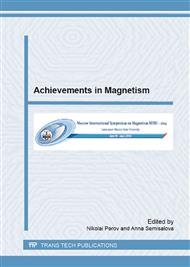[1]
A.E. Clark, Magnetostrictive RFe2 intermetallic compounds, Eds. K.A. Gschneider, Handbook on the Physics and Chemistry of Rare-Earth, North-Holland publishing company, 1979, p.231.
DOI: 10.1016/s0168-1273(79)02006-7
Google Scholar
[2]
G.V. Brown, Magnetic heat pumping near room temperature, J. Appl. Phys. 47 (1976) 3673.
Google Scholar
[3]
Niraj K. Singh, S. Agarwal, K.G. Suresh, R. Nirmala, A.K. Nigam, S.K. Malik, Anomalous magnetocaloric effect and magnetoresistance in Ho(Ni, Fe)2 compounds, Phys. Rev. B. 72 (2005) 014452.
Google Scholar
[4]
Niraj K. Singh, K.G. Suresh, D.S. Rana, A.K. Nigam, S.K. Malik, Role of Fe substitution on the anomalous magnetocaloric and magnetoresistance behaviour in Tb(Ni1−xFex)2 compounds, J. Phys.: Condens. Matter. 18 (2006) 10775.
DOI: 10.1088/0953-8984/18/48/005
Google Scholar
[5]
X.B. Liu, Z. Altounian, Magnetocaloric effect in Co-rich Er(Co1−xFex)2 Laves phase, J App. Phys. 103 (2008) 07B304.
DOI: 10.1063/1.2829758
Google Scholar
[6]
Madhumita Halder, S.M. Yusuf, M.D. Mukadam, K. Shashikala, Magnetocaloric effect and critical behavior near the paramagnetic to ferrimagnetic phase transition temperature in TbCo2−xFex, Phys. Rev. B. 81 (2010) 174402.
DOI: 10.1103/physrevb.81.174402
Google Scholar
[7]
Zou Jun-Ding, Shen Bao-Gen, Sun Ji-Rong, Magnetic properties and magnetocaloric effect in TbCo2-xFex compounds, Chinese Phys. 16 (2007) 3843.
DOI: 10.1088/1009-1963/16/12/048
Google Scholar
[8]
K.A. Gschneidner Jr, V.K. Pecharsky and A.O. Tsokol, Recent development in magnetocaloric materials, Rep. Prog. Phys. 68 (2005) 1479–1539.
DOI: 10.1088/0034-4885/68/6/r04
Google Scholar
[9]
Z. Han, Z. Hua, D. Wang, C. Zhang, B. Gu, Y. Du, Magnetic properties and magnetocaloric effects in Dy(Co1-xFex)2 alloys, J. Magn. Magn. Mater. 302 (2006) 109–112.
DOI: 10.1016/j.jmmm.2005.08.013
Google Scholar
[10]
K.A. Gschneidner Jr., V.K. Pecharsky, Magnetocaloric materials, Annu. Rev. Mater. Sci. 30 (2000) 387.
DOI: 10.1146/annurev.matsci.30.1.387
Google Scholar
[11]
M. Balli, D. Fruchart, D. Gignoux, J. Magn. Magn. Mater. 314 (2007) 16.
Google Scholar
[12]
A.V. Deryagin, N.V. Kudrevatykh, V.N. Moskalev, Magnetic anisotropy and intersublattice exchange interaction in Er2(Co1-xFex )17, Phys. Status Solidi (a), 45(1979) 71-76.
DOI: 10.1002/pssa.2210450106
Google Scholar
[13]
A.A. Kazakov, V.A. Reymer, Concentrational dependence of magnetic anisotropy constants in rare-earth intermetallic compounds, Phys. Met. & Metallography, 41 (1976) 29-32 (in Russian).
Google Scholar


